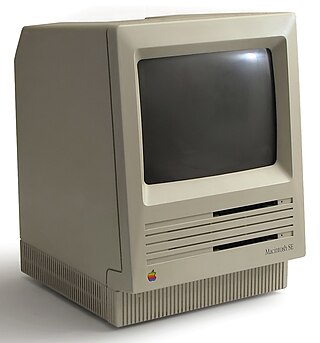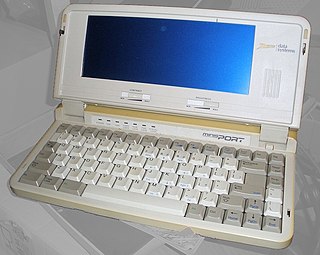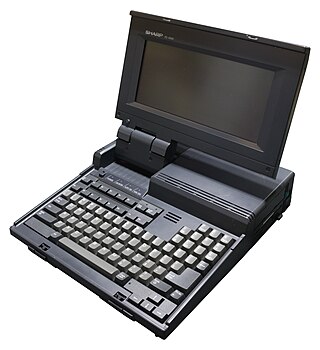
Amstrad was a British consumer electronics company, founded in 1968 by Alan Sugar. During the 1980s, the company was known for its home computers beginning with the Amstrad CPC and later also the ZX Spectrum range after the Sinclair deal, which led it to have a substantial share of the PC market in Britain. In the following decade it shifted focus towards communication technologies, and its main business during the 2000s was the manufacture of satellite television set-top boxes for Sky, which Amstrad had started in 1989 as the then sole supplier of the emerging Sky TV service.

The Tandy 1000 is the first in a line of IBM PC compatible home computer systems produced by the Tandy Corporation for sale in its Radio Shack and Radio Shack Computer Center chains of stores. Introduced in 1984, the product line was aimed at providing affordable but capable systems for home computing or education, with some of its Tandy specific features like graphics, sound and joystick port making it more appealing for home use.

The Personal System/2 or PS/2 is IBM's second generation of personal computers. Released in 1987, it officially replaced the IBM PC, XT, AT, and PC Convertible in IBM's lineup. Many of the PS/2's innovations, such as the 16550 UART, 1440 KB 3.5-inch floppy disk format, 72-pin SIMMs, the PS/2 port, and the VGA video standard, went on to become standards in the broader PC market.

The Macintosh SE is a personal computer designed, manufactured, and sold by Apple Computer, from March 1987 to October 1990. It marked a significant improvement on the Macintosh Plus design and was introduced by Apple at the same time as the Macintosh II.

The PowerBook G3 is a series of laptop Macintosh personal computers designed, manufactured, and sold by Apple Computer from 1997 to 2001. It was the first laptop to use the PowerPC G3 (PPC740/750) series of microprocessors, and was marketed as the fastest laptop in the world for its entire production run. The PowerBook G3 was succeeded by the PowerBook G4.

The Macintosh Classic II is a personal computer designed and manufactured by Apple Computer, Inc. from October 1991 to September 1993. The system has a compact, appliance design with an integrated 9" monitor, typical of the earliest of the Macintosh range. A carrying handle moulded into the case added a degree of portability at a time when laptops were still relatively uncommon.

The Zenith MinisPort is a subnotebook based on an 80C88 CMOS CPU running at two software selectable speeds: 4.77 MHz or 8 MHz. It was released in 1989 by Zenith Data Systems (ZDS).

The Compaq Portable II is the fourth product in the Compaq Portable series to be brought out by Compaq Computer Corporation. Released in 1986 at a price of US$3499, the Portable II much improved upon its predecessor, the Compaq 286, which had been Compaq's version of the PC AT in the original Compaq Portable chassis; Portable 286 came equipped with 6/8-MHz 286 and a high-speed 20-MB hard drive, while the Portable II included an 8 MHz processor, and was lighter and smaller than the previous Compaq Portables. There were four models of the Compaq Portable II. The basic Model 1 shipped one 5.25" floppy drive and 256 KB of RAM. The Model 2 added a second 5.25" floppy drive and sold for $3599. The Model 3 shipped with a 10MB hard disk in addition to one 5.25" floppy drive and 640 KB of RAM for $4799 at launch. The Model 4 would upgrade the Model 3 with a 20MB hard drive and sold for $4999. There also may have been a 4.1 MB hard drive included at one point. The Compaq Portable II was significantly lighter than its predecessors, the Model 1 weighed just 23.6 pounds compared to the 30.5 pounds the Compaq Portable 286 weighed. Compaq only shipped the system with a small demo disk, MS-DOS 3.1 had to be purchased separately.

The Z-89 is a personal computer introduced in 1979 by Heathkit, but produced primarily by Zenith Data Systems (ZDS) in the early 1980s. It combined an updated version of the Heathkit H8 microcomputer and H19 terminal in a new case that also provided room for a built-in floppy disk on the right side of the display. Based on the Zilog Z80 microprocessor it is capable of running CP/M as well as Heathkit's own HDOS.

The Compaq Presario 1200 was a line of notebook computers produced between 1998 and 2000 by Compaq as part of Compaq Presario line.

The Toshiba T1100 is a laptop manufactured by Toshiba in 1985, and has subsequently been described by Toshiba as "the world's first mass-market laptop computer". Its technical specifications were comparable to the original IBM PC desktop, using floppy disks, a 4.77 MHz Intel 80C88 CPU, 256 KB of conventional RAM extendable to 512 KB, and a monochrome LCD capable of displaying 80x25 text and 640x200 CGA graphics. Its original price was 1899 USD.

The Toshiba T1000 is a discontinued laptop computer manufactured by the Toshiba Corporation in 1987. It has a similar specification to the IBM PC Convertible, with a 4.77 MHz 80C88 processor, 512 KB of RAM, and a monochrome CGA-compatible LCD. Unlike the Convertible, it includes a standard serial port and parallel port, connectors for an external monitor, and a real-time clock.

The history of laptops describes the efforts, begun in the 1970s, to build small, portable Personal Computers that combine the components, inputs, outputs and capabilities of a Desktop Computer in a small chassis.

IBM ThinkPad 760 was a notebook computer introduced in 1995 by the IBM corporation into the market as part of the ThinkPad 700-series. It was succeeded in 1998 by the ThinkPad 770 series.

The Toshiba T3100 is a discontinued portable PC manufactured by Toshiba released in 1986. It features a 10 MB hard drive, 8 MHz Intel 80286 CPU and a black & orange 9.5" gas-plasma display with a resolution of 640x400 pixels.

The Compaq Portable III is a PC/AT-compatible computer released by Compaq Computer Corporation in 1987. It was advertised as being much smaller and lighter than the previous portable x86-PCs; however it was still quite large by today's standards. Three models were announced at release. The Model 1 had a list price of $3999 USD and was equipped with a 12 MHz Intel 80286, 640 KB of RAM, 1.2 MB 5.25" floppy drive, and a 10" amber colored gas-plasma display. Other models included the Model 20 at $4999 USD which added a 20 MB hard disk, or $5799 for the Model 40 with the upgraded 40 MB hard disk.
Toshiba Pasopia 16 or PA7020 is an IBM PC compatible computer from manufacturer Toshiba, released in 1982 and based around a Intel 8088-2 microprocessor running at 6 MHz.

The Sharp PC-4500 is a line of laptop computers released by Sharp Corporation in 1987. The line comprises the PC-4501, the PC-4502, and the PC-4521. The PC-4501 is a bare-bones unit with only 256 KB of RAM stock, only one floppy drive, no backlighting, and no built-in numeric keypad; the PC-4502 and PC-4521 bumps the stock RAM to 640 KB and includes the latter two features while providing either two floppy drive (PC-4502) or one floppy drive and a 20 MB hard drive (PC-4521). Prices on the line initially ranged from $1,295 to just under $3,000; the PC-4501 was later sold for $995, becoming one of the first sub-$1,000 laptops available on the market. The PC-4500 line received mixed, mostly positive, reviews on its release in September 1987.

The Personal System/2 Model 30 and Personal System/2 Model 30 286 are IBM's entry-level desktop computers in their Personal System/2 (PS/2) family of personal computers. As opposed to higher-end entries in the PS/2 line which use Micro Channel bus architecture, the Model 30 features an Industry Standard Architecture bus, allowing it to use expansion cards from its direct predecessors, the PC/XT and the PC/AT. The original PS/2 Model 30 is built upon the Intel 8086 microprocessor clocked at 8 MHz; the Model 30 286 features the Intel 80286 clocked at 10 MHz.

The SupersPort is a line of PC-compatible laptops manufactured by Zenith Data Systems and sold from 1988 to 1993. The first two main entries in the SupersPort line included either an Intel 80286 microprocessor clocked at 12 MHz or an 8088 processor clocked at 8 or 4.77 MHz, switchable. Later entries included the 386SX, 486SX and 486 processors. The SupersPort 286 in particular was one of the top-selling laptops of the late 1980s, although Zenith's position in this segment faltered by the early 1990s.



















